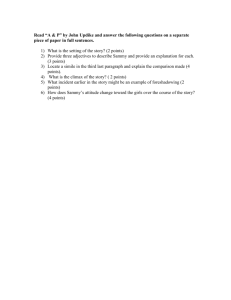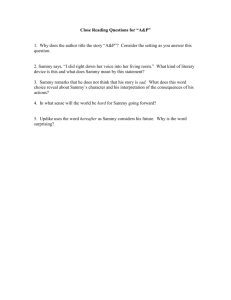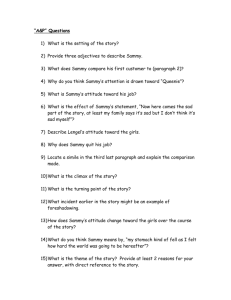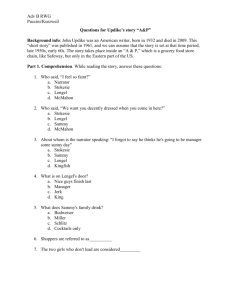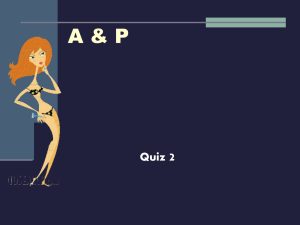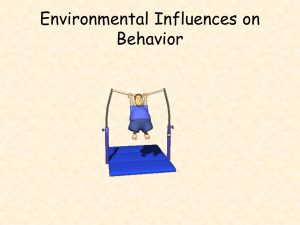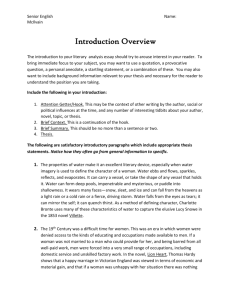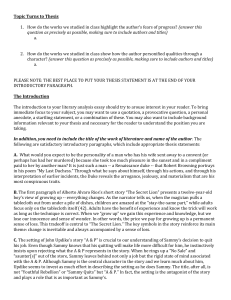Document
advertisement
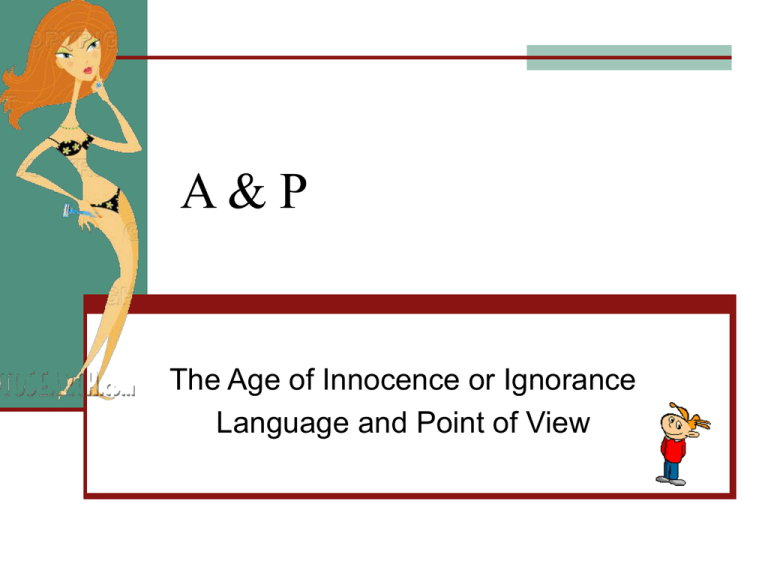
A&P The Age of Innocence or Ignorance Language and Point of View Housekeeping 1. play rehearsal 12/10 (Wed) noon and advisor time 2. e-text vs. textbook 3. group advisor: Group 1-4: Kate Group 5-8: Julia Group 9-12: Andrew Our email address: introlit2014@gmail.com Outline 1. Q & A & General Introduction 2. Structure Queenie in grace, disgraced, and the “hero” fights back to no avail. 3. Language and Style contrasting two kinds of people 4. Discussion: a. Points of View b. Ending c. The Swimming Suit Issue: Sammy vs. the Other Characters d. Setting & Theme A&P General Introduction John Updike & “A&P” Updike on “A&P” John Updike (1932–2009) Originally he had 3 more pages describing Sam’s going up to the beach to find the girls, but without success A filmic adaptation, followed by an interview Norton “A&P” Characters Sammy Lengel, Stokesie, McMahon (at the meat counter) 3 girls: (par 2) The First Friend (“Plaid”) The Second Friend (“Big Goony Goony) Queenie Customers Structure –Rescuing the Queen 1. Beginning: In media res – in the middle of a sequence of an event or a story. Long description of the three girls with a focus on Queenie, juxtaposed with short descriptions of the other customers. 2. Middle: “Now here comes the sad part of the story” (par 11) confrontation between the girls and Lengel; Between Lengel and Sammy 3. Ending: out of the supermarket. “A&P” Structure In medias res (Latin "in the midst of things") Beginning (1-10) • The three girls come in and described Middle: Lengel .vs. the girls (1121) • “Now here comes the sad part of the story” …all the time thinking Conclusion (22-32) Sam vs. Lengel • “I quit” I felt how hard the world was going to be to me hereafter Q&A: Your Responses Why did Stokesie call the author "Daddy"? (Since Stokesie was older than him.) "Oh Daddy," Stokesie said beside me. "I feel so faint.“ (7) "Darling," I said. "Hold me tight." Stokesie's married, with two babies chalked up on his fuselage already, but as far as I can tell that's the only difference. He's twenty-two, and I was nineteen this April. (8) Sammy’s Language: Your Choice (team 8!) 1.Sammy's os - a good tan and a sweet broad soft-looking can with those two crescents of white just under it. Bright green and the seams on the bra. 2.description of Queenie - Sammy thinks the most beautiful girl is untouchable , so he nicknames her "Queenie", which refers as "Queen.“ For example, she held her head so high her neck,......;but I (Sammy) doesn't mind. The longer her neck is ,the more of her there is. (par 4) Sammy’s Language: Your Choice 3.argument with the boss - It begins with Sammy saying "I quit !" Just because the girls are embarrassed by the boss. It shows that Sammy is like other teenagers, who always do something without thinking twice. However a sudden impulse made Sammy quit his job, neglecting what the boss says and what his parents' feeling. In the end, it turned out that Sammy does regret when he turns back, seeing his boss ringing up, with a dark gray face standing alone. Sammy’s Language (1) 1. Colloquial: omission, rep, coined words, run-on S and misplaced modifier – pars 13, 52 –first sentences.) 2. Concrete with vivid details and things he is familiar with (e.g. games, women’s bodily parts-breasts and bottoms, supermarket) 3. Vivid and imaginative: e.g. the girl’s voice (par 14), the sound of the cash register (par 21). Sammy’s Language (2) 4. Stereotyping and exaggerative: Tends to divide up people into two groups--one he likes, and one he dislikes—and exaggerates their differences. (e.g. Sheep vs. Queen) e.g. “You could see them [the other customers], when Queenie's white shoulders dawned on them, kind of jerk, or hop, or hiccup, but their eyes snapped back to their own baskets and on they pushed.” (par 5) Other descriptions of the customers (par 12, 30) e.g. Queenie vs. the dynamites Example of Sammy’s Language (3)— Queenie Queenie:-- sex + queenly manners The way she walks; square-shouldered and longnecked. “the oaky hair that the sun and salt had bleached.” She had on a kind of dirty-pink—beige maybe, I don't know—bathing suit with a little nubble all over it and, what got me, the straps were down; shining rim; top of her chest like “a dented sheet of metal tilted in the light” The bill from the girl’s cleavage: “from between the two smoothest scoops of vanilla I had ever known...." Summary and Preview: Point of View Participant (or first-person) point of view; --1) as protagonist: e.g. “A & P,” “Boys and Girls” “Araby” -- 2) as witness (“we” –”A Rose for Emily”) (*Issue—reliable nor not) Non-participant (or third-person) point of view. --1) neutral omniscience –objective --2) editorial omniscience – (with judgment) --3) selective omniscience -- e.g. “20/20” Enter the mind or not; stream of consciousness (later) Discussion Questions Group 1, 5, 9- Point of View –Sammy’s vs. Queenie’s or Lengel’s (description or performance of dialogue) Group 2, 6, 10- Ending –What do we make of it? Would you quit the job if you were in Sam’s position? Which ending do you prefer?* Group 3, 7, 11- Swimming Suit or not: The Girls’, Sammy’s, Lengel’s, Stoksie’s and the Other Customers’ Points of View (description or performance) Group 4, 8. 12- Setting & Theme (analysis or recreation) http://www.youtube.com/watch?v=OJImoQJsgEs Let’s Take a Break!!! And start our group discussion 10:16- 11:06 Come back to this classroom at 11:16 sharp! Period 2: Discussion Time 10:1011:00 2-groups’ (1,2, 7,8) presentation, (9, 10, 3, 4) practice raising questions Question Group no. 1 2 3 4 1 2 3 4 Group no. 5 6 7 8 Group no. 9 10 11 12 3rd hour: (5. 6. 11, 12) present; (9, 10, 3, 4) ask questions Point of View: Related Issues the “I-narrator” is not the author E.g. “The author described the woman as a "witch". This analogy not only described her appearance, but also her personality. She likes to pick on others, and Sammy was the victim this time.” Sense of Immediacy, sympathy –induced by first- person point of view? “A & P” Objectivity, human littleness? –suggested by thirdperson point of view? “20/20”? Only one point of view in telling a story? No. The change of point of view or tone means a lot. The Character (1)—Sammy & Queenie 1. Is he a sexist? Attentive to sexual details and judgmental (“Queenie and Plaid and Big Tall Goony-Goony (not that as raw material she was so bad), ”); 2. About the girls’ minds: “You never know for sure how girls' minds work (do you really think it's a mind in there or just a little buzz like a bee in a glass jar?) ” 3. Wants to play hero, but he is not and cannot be one. 4. His move futile; he is self-centered, but he is indeed courageous. How about Queenie? The Queen –Is she really queenly? 1. Seemingly proud and self-assured – slow-motioned and a bit exaggerated in her walk; Holds her head tall; 2. In response to Lengel Her voice when speaking to Lengel; (par. 14) Feeble attempt at defending herself: “We’re decent.” (par 18) 3. Her family background, different from Sammy’s Class Differences between Q & S Herring snacks Lemonade and Schlitz Cocktail Drink with olive (beer) Glasses with cartoon figures Par. 14 Sammy’s Point of View of the “Sheep“ The middle-aged customer --"about fifty," and a "witch" of the sort he's learned once flourished in nearby Salem; with"rouge on her cheekbones and no eyebrows" but nothing else that might stir him in the direction of sympathy.” (par 1) I bet you could set off dynamite in an A&P and the people would by and large keep reaching and checking oatmeal off their lists and muttering . . .(par 5) "house slaves in pin curlers“; (par 5) "old party in baggy gray pants who stumbles up [to his checkout lane] with four giant cans of pineapple juice" (par 12) "women with six children and varicose veins mapping their legs." (par 10) "like scared pigs in a chute“; (par 30) Is Sammy a reliable narrator? Ending (1): What Happens? “"You'll feel this [regret] for the rest of your life," Lengel says, and I know that's true, too.” The girls gone; Sammy’s action: “I just saunter into the electric eye in my white shirt that my mother ironed the night before, and the door heaves itself open, and outside the sunshine is skating around on the asphalt.” Sammy’s feeling: “His face was dark gray and his back stiff, as if he'd just had an injection of iron, and my stomach kind of fell as I felt how hard the world was going to be to me hereafter.” Ending (2): What Happens? After Sammy quits, he goes out to the parking lot and sees not the girls, but “some young married screaming with her children about some candy they didn’t get.” What do you think about the ending? Has Sammy achieved anything? Or arrived at some type of awareness of his future prospect? Swimming Suit Issue 1. Social Propriety: Respecting local customs and manners 2. Avoiding confrontation 3. Swimming suit’s symbolic meaning: freedom, leisure, sexuality Putting Sammy in his Position Analyzing 1. his Point of View (vs. the Others) and 2. his Social Position (in the Setting) Sammy in Context (1): the Other Characters (2): Stokesie, McMahon and Lengel. Stokesie – ‘"Oh Daddy," Stokesie said beside me. "I feel so faint." "Darling," I said. "Hold me tight." Stokesie's married, with two babies chalked up on his fuselage already, but as far as I can tell that's the only difference.” . . .wants to be a manager. old McMahon—”patting his mouth and looking after them sizing up their joints. Poor kids, I began to feel sorry for them, they couldn't help it.” Lengel: patient and old and gray more practical or less polite in their stare at the girls. How would they look at Sammy? How about the shoppers? Sammy in Context (2): Setting & Imagery Symbolic Meanings? Supermarket: fluorescent light (vs. sunlight), checkerboard green-and-cream rubber-tile floor.(par 6) A lot of merchandize: e.g. a pyramid of Diet Delight peaches, Caribbean Six or Tony Martin Sings, plastic toys, etc.. Images of the mundane, the business world and capitalism which places people, as consumers and workers, in different classes and increases their differences. What difference would it make if this story were placed in another setting? Theme and Message The story as an initiation story (成長故事) in which the 19-year-old Sammy has a rite of passage (成年禮) at a supermarket. Self (Personal Aspiration) against Society (Social Control) Does he grow up? Yes, he realizes he cannot be a hero. But his realization is a bit self-centered and too dramatic. Next Time Another initiation story. Be patient when reading the images which will later take on symbolic meanings when they get grouped together (in image clusters).
